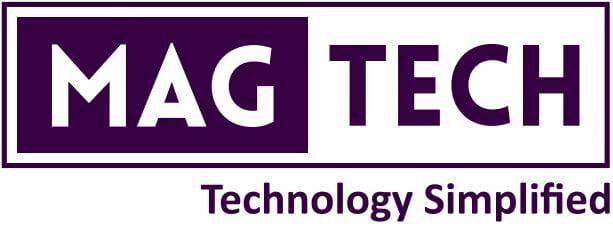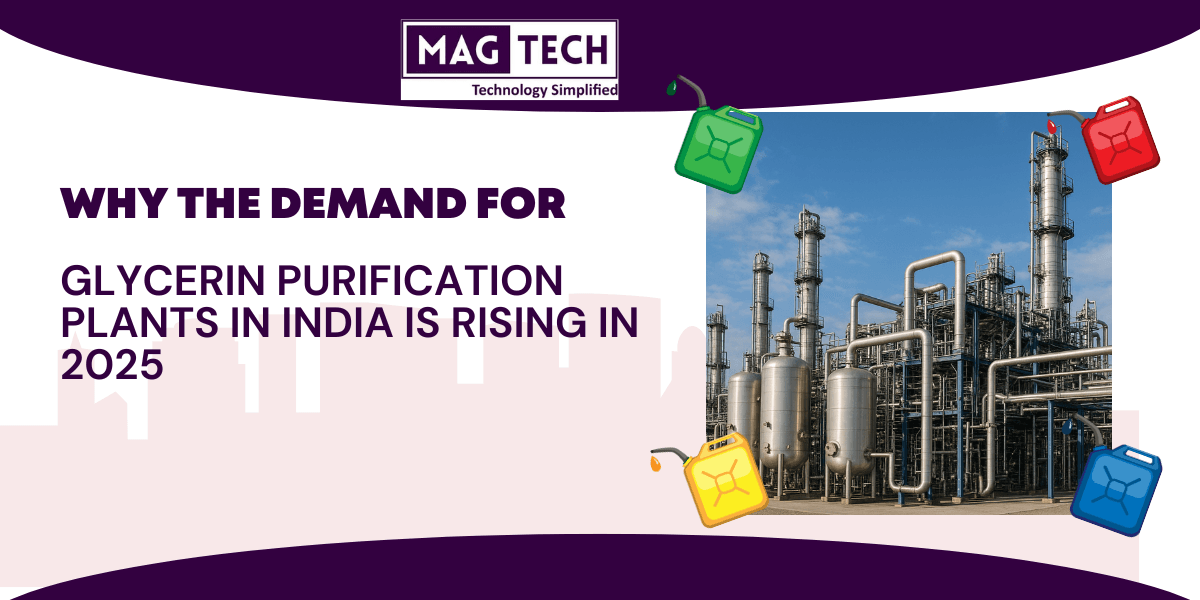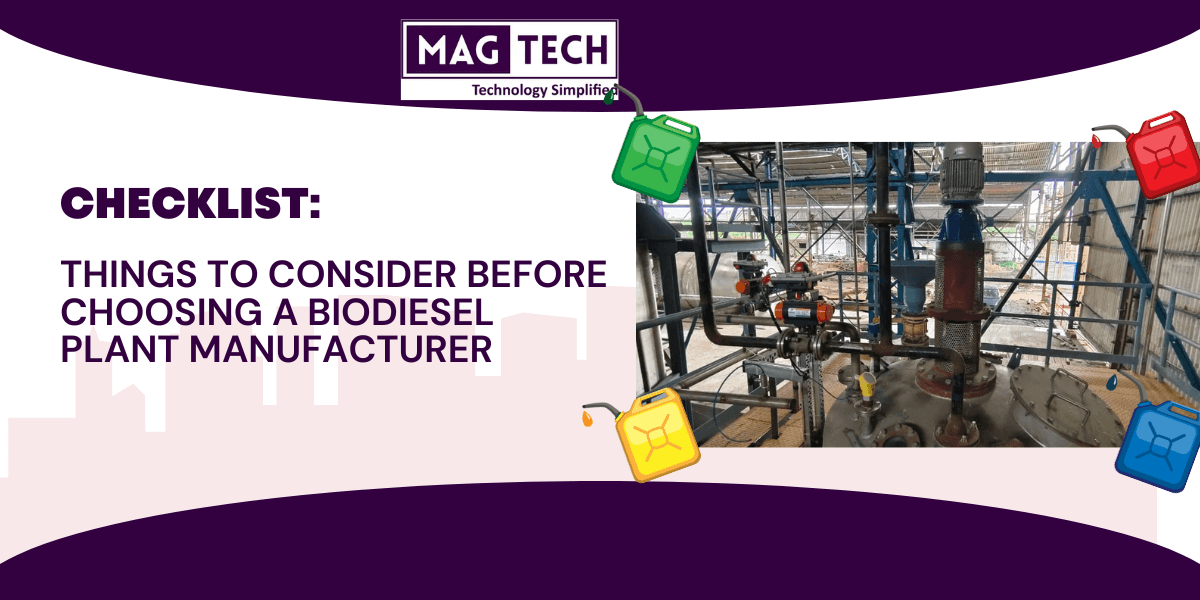India’s energy map is changing fast, and bioethanol is at the centre of this shift. With rising fuel demand, high crude oil imports, and a strong push for cleaner alternatives, bioethanol offers a practical solution.
It reduces the oil import bill and also supports farmers by creating demand for crops like sugarcane and maize. The government’s Ethanol Blending Program (EBP) has already moved India close to 20% blending, opening up a stable, policy-backed market.
For entrepreneurs and investors, this creates a unique opportunity to explore first-generation (1G) bioethanol technologies and tap into a fast-growing sector. Let’s go deep and find out what it is, technologies related to its production and market potential.
Table of Contents
ToggleWhy 1G Bioethanol is Emerging as India’s Next Big Energy Opportunity?
First-generation (1G) bioethanol is produced by fermenting sugars and starches from feedstocks such as sugarcane, molasses, maize, and surplus grains. It is one of the most practical biofuels for India because the country already has a large agricultural base and established distillery infrastructure.
Today, bioethanol plays a dual role: it helps reduce dependence on imported crude oil and lowers greenhouse gas emissions in line with India’s clean energy commitments.
The opportunity is significant. India’s Ethanol Blending Programme (EBP) has already pushed average blending levels to nearly 19% in 2024–25, with national E20 now within reach. This creates a stable, long-term demand backed by government policy and supported by continuous procurement from oil marketing companies (OMCs).
For entrepreneurs, this means a ready market with a predictable offtake. For investors, it signals policy security and revenue visibility. With increasing capacity across states and the government encouraging multi-feedstock plants, 1G bioethanol is a niche opportunity for a mainstream investment avenue in India’s energy transition.
Government Push and Market Demand: Secure Future in India
India’s bioethanol sector is driven largely by strong government support. Its progress demonstrates clear momentum and gives investors confidence that demand for bioethanol will remain steady and policy-backed.
Oil Marketing Companies (OMCs) play a central role by issuing regular tenders and assuring long-term offtake. This guarantees a market for the producers and reduces revenue risk for new projects.
Additionally, the government allows multiple feedstocks like sugarcane juice, B-heavy molasses, C-heavy molasses, maize, surplus rice, and damaged grains, providing flexibility to producers and helping balance seasonal supply issues.
Policy measures go beyond blending targets. Financial incentives, interest subvention schemes, and faster clearances for distilleries further strengthen the investment environment. Even with debates around vehicle compatibility and environmental considerations, the policy direction is clear: India wants to cut its oil import bill and promote cleaner fuels.
Here’s the market size, capacity and regional pivots that are setting an example for entrepreneurs to invest in this sector.
Bioethanol Market Size, Capacity & Regional Hotspots
India’s 1G bioethanol sector is building strong momentum, backed by policy, infrastructure, and regional strengths.
National Capacity & Growth Trajectory
The bioethanol production capacity in India has more than doubled in a few years, rising from approximately 423 crore litres in 2019–20 to about 947 crore litres by 2022–23. This includes ~619 cr L molasses-based and ~328 cr L grain-based capacity.
By late 2024, capacity climbed further. OMCs allocated 947 crore litres for ESY 2024–25, and are now raising that allotment to 1,050 crore litres to sustain the E20 push.
Bioethanol offtake & Blending Trends
Public sector OMCs’ bioethanol blending under the EBP programme soared from just 38 crore litres in ESY 2013–14 to 707 crore litres in ESY 2023–24, corresponding to a ~14.6% blend.
By mid-2025, India reached a national average blending rate of 18.93%, with several states, including Punjab, West Bengal, Karnataka, and Kerala, surpassing the 19% mark.
Regional Feedstock & Capacity Hotspots
The market potential largely aligns with its sugarcane belt. States leading in molasses availability include Uttar Pradesh (432 Mt sugarcane), Maharashtra (368 Mt), and Karnataka (238 Mt). Other notable states: Bihar, Punjab, Gujarat, and Andhra Pradesh. This feedstock advantage underpins capacity and future projects.
Notable regional highlights:
- Gujarat: Around 14 companies approved bioethanol plant setups, planning nearly 2,800 KLPD capacity (≈1,022 crores L/year) with total investment ~₹3,300 crore.
- Bihar: Operating 12 bioethanol mills yielding 5.65 billion litres, exporting about 60% to southern states. Nine new plants targeted by 2026.
- Odisha: Under the Ethanol Interest Subvention Scheme, the central government approved assistance for 29 bioethanol projects to boost production in the state.
Let’s dig deeper to find out the feedstocks for 1G bioethanol and then proceed to its processing, technology, and economics.
1G Bioethanol Feedstocks 101 — What Actually Works at Scale
Understanding the different feedstock options is the focal point of building a resilient, cost-effective 1G bioethanol plant in India. Here’s a breakdown of the main feedstocks, their advantages, challenges, and what makes them viable at scale:
1. Molasses from Sugarcane
- C-heavy molasses: A by-product of sugar refining with higher sugar content and bioethanol yields. It tends to be more stable in price and is easier to ferment efficiently.
- B-heavy molasses: Lower in fermentable sugars, but more abundant and less expensive. Ideal when cost-efficiency is of the highest importance, though yields are slightly lower.
- Special molasses (sugarcane juice or syrup): Used when distilleries opt for direct juice-based fermentation, enabling potentially higher yields, but also more seasonal and requiring fresher feedstock logistics.
2. Grain-based Feedstocks (e.g. Maize, Damaged Rice, Surplus Grains)
- Maize & grains: These are increasingly used due to periodic excess stocks or government allocations (e.g., FCI-released surplus or damaged rice). Grain fermentation requires additional steps like milling, liquefaction, and saccharification.
But it can generate DDGS (Dried Distillers Grains with Solubles) as a high-value co-product. Local and export demand for DDGS provides an attractive revenue stream.
- Price volatility can be higher due to competition with animal feed and food markets, but government programs often allocate grain specifically for bioethanol to help manage this.
3. Balancing Act & Co-Products
- Feedstock flexibility: In practice, plants that can switch between molasses and grains depending on seasonal availability achieve better cost stability and higher annual utilisation.
- Co-products:
- From molasses: Vinasse, which requires proper management, either used as fertilizer, sent to biogas units, or evaporated for Zero Liquid Discharge (ZLD) compliance.
- From grains: DDGS, a protein-rich animal feed with growing demand, and CO₂, which can be captured and monetized for industrial uses.
Why It Matters
Feedstock selection defines your CIP (continuous improvement program), capex/opex structure, and offtake strategy. A smart plant design using multi-feedstock systems and maximizing co-product value drives market resilience, higher margins, and investor appeal.
1G Bioethanol Core Process Blocks & Technology Choices
A 1G bioethanol plant is a sequence of proven unit operations. For investors, the right technology choices determine throughput, operating cost, product quality and regulatory compliance.
Below is a practical, investor-focused guide to the core blocks and commonly adopted technologies.
Feed preparation & saccharification
For grain routes, feedstock is milled, liquefied and saccharified using thermostable α-amylases and glucoamylases before fermentation. These enzymatic steps add cost but are essential to convert starch to fermentable sugars and enable high-conversion yields.
For molasses/juice routes, preparation focuses on dilution, clarification and pH control to protect yeast performance. Choosing robust, industrial enzyme suppliers and optimized dosing reduces overall enzyme cost and improves yield.
Fermentation — batch, fed-batch and high-gravity options
Modern plants use high-gravity (HG) or very-high-gravity (VHG) fermentation to increase bioethanol concentration at the fermenter outlet, improving distillation energy efficiency and reducing effluent volumes.
HG/VHG requires robust yeast strains, careful osmo-stress control, oxygen management during the growth phase, and staged nutrient addition, trades that increase CAPEX slightly but lower OPEX and increase throughput per fermenter. Continuous/automated fermentation lines can further raise capacity but need stronger process control.
Distillation & multi-pressure design
Distillation typically uses a mash (beer) column followed by a rectification column to reach ~95% (v/v) bioethanol before dehydration. Multi-pressure distillation, combined with modern tray/packing designs and heat integration, cuts steam demand, a major running cost.
It is a common retrofit target for revamps. Heat recovery between columns and reboilers materially improves plant economics.
Dehydration: Molecular sieve (MSDH) & alternatives
To reach fuel-grade anhydrous bioethanol (~99.7%), molecular sieve dehydration (pressure-swing adsorption on 3A/4A zeolite beds) is the industry standard.
Hybrid systems (distillation + MSDH) are reliable, modular, and quick to commission. Vendors provide skid-mounted MSDH packages that simplify brownfield upgrades. MSDH operation and regeneration energy must be sized carefully to balance uptime and energy use.
Utilities & energy integration (cogen, boilers, MEE)
Steam balance is critical: boiler sizing, feedstock for boilers (bagasse, biomass or coal), and cogeneration potential directly affect cash flows. Many sugar-bioethanol complexes use bagasse cogeneration to offset grid purchases and even export power.
Multi-effect evaporators (MEE) reduce spent-wash volumes and are integral to ZLD strategies; integrated designs maximize condensate reuse and reduce freshwater draw.
Effluent management & ZLD
Regulatory compliance (CPCB/state boards) increasingly requires ZLD or very low discharge from distilleries. Typical solutions: bio-methanation (anaerobic digestion) → MEE → bio-composting or incineration of MEE concentrate.
These systems add CAPEX but are non-negotiable for lenders and offtakers. Early EIA/effluent planning avoids costly retrofits.
Automation, modularization & skid-based deliveries
Advanced DCS/PLC automation improves fermentation consistency and reduces labour risk; skid-mounted fermenters, MSDH units, and packaged utilities speed execution and control commissioning risk. For investors, modular scopes reduce schedule and cost overruns and simplify phased capacity expansion.
Investor KPIs to watch
- Steam consumption (kg steam/L bioethanol) — energy is a dominant OPEX driver.
- Yield (L bioethanol/tonne feedstock) — determines feedstock cost exposure.
- Plant availability (%) and turnaround time for MSDH beds — affects revenue continuity.
- Effluent volume and ZLD operating cost — a lender checklist item.
Breaking down such technological requirements and understanding the current market requires an experienced consultant to draw an entrepreneurial plan.
Turn Opportunity into a Winning Bioethanol Venture with MAGTECH
India’s 1G bioethanol sector is entering a high-growth phase, powered by policy, demand security, and strong regional feedstock availability. For entrepreneurs and investors, success will depend on choosing the right technology partner who can deliver efficiency, compliance, and scalability from day one.
MAGTECH offers end-to-end solutions, from feedstock studies and plant design to commissioning, automation, and ZLD compliance to ensure faster execution and lower risk.


